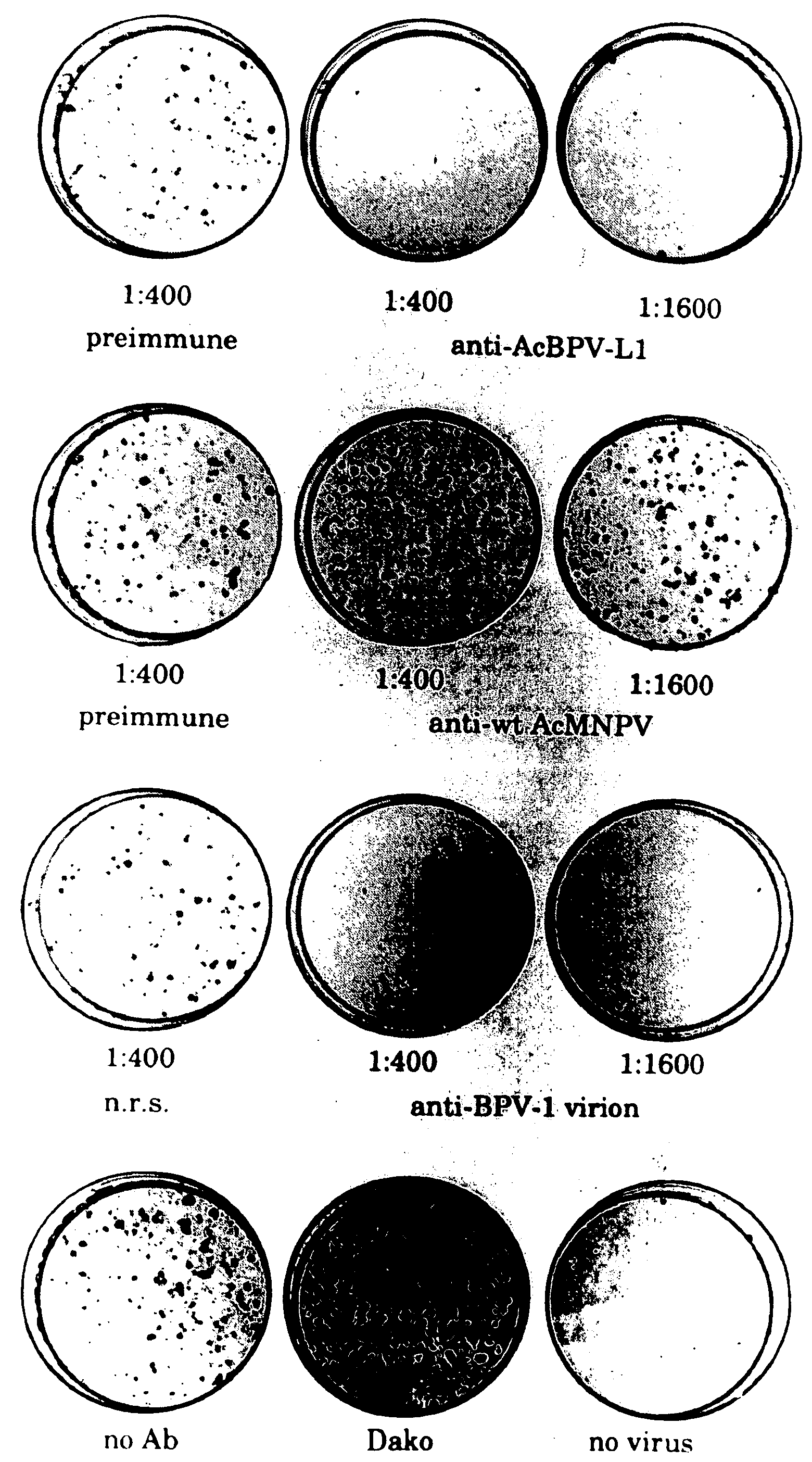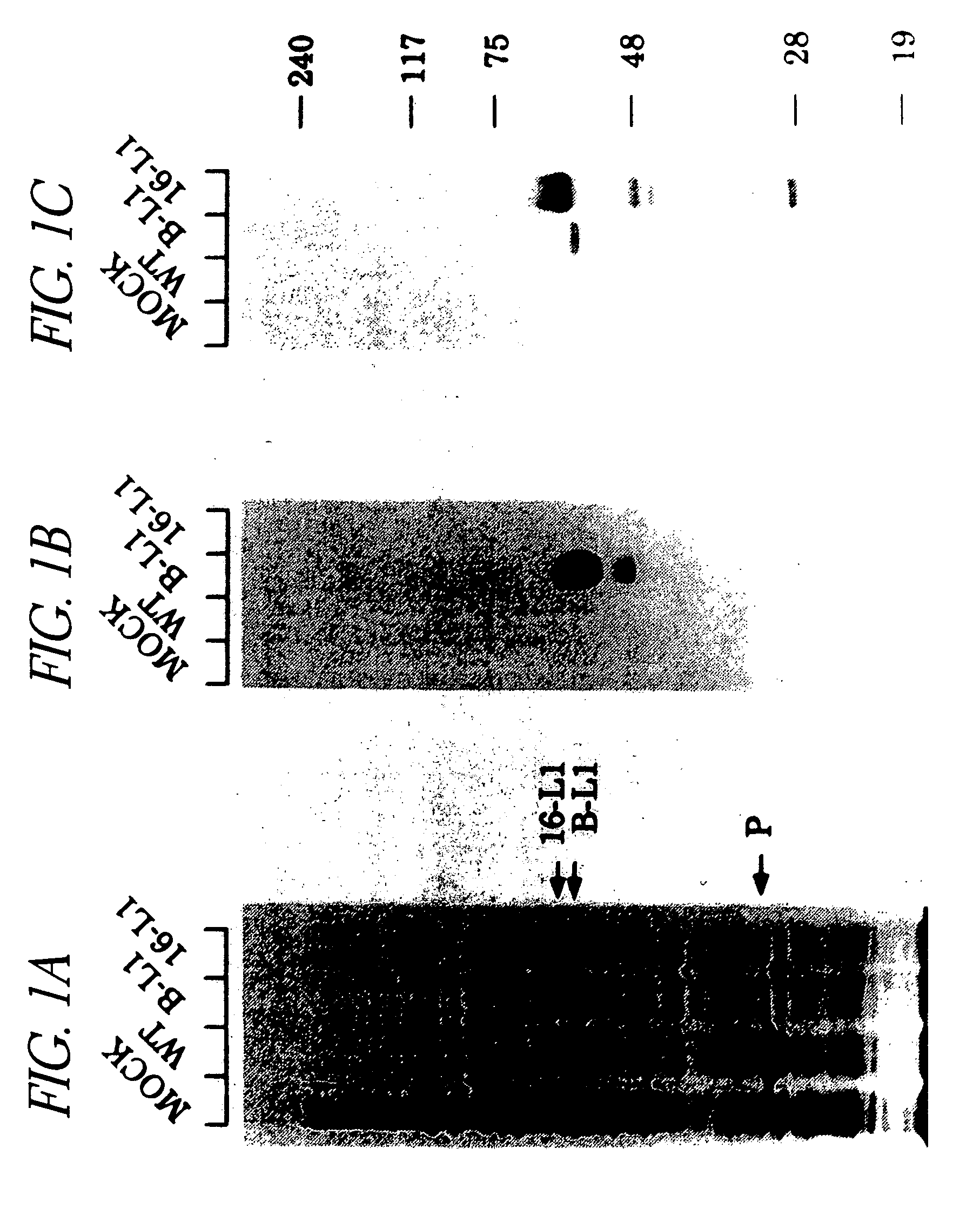Self-assembling recombinant papillomavirus capsid proteins
a recombinant papillomavirus and capsid protein technology, applied in the field of self-assembling recombinant papillomavirus capsid proteins, can solve the problems of inability to generate in vitro the large amount of infectious virus required to develop vaccines against papillomavirus, bpv virions cannot be used to develop vaccines, etc., to facilitate the production of preparative amounts of virus-like particles
- Summary
- Abstract
- Description
- Claims
- Application Information
AI Technical Summary
Benefits of technology
Problems solved by technology
Method used
Image
Examples
example 1
[0071] Full length L1, or L1 and L2 open reading frames (ORF) were amplified by PCR using the cloned prototypes of BPV1 DNA (Chen, E., et al., 1982), GenBank Accession No. X02346 or HPV16 DNA (Seedorf, K., et al., 1985), GenBank Accession No. K02718; or wild type HPV16 DNA (SEQ ID NO: 3) as templates. Unique restriction sites were incorporated into the oligonucleotide primers (underlined). [0072] BPV1 L1 primer sequence (SEQ ID NO: 5): 5′ CCGCTGAATTCAATATGGCGTTGTGGCAACAAGGCCAGAAGCTGTAT 3′ (sense) and (SEQ ID NO: 6): 5′ GCGGTGGTACCGTGCAGTTGACTTACCTTCTGTTTTACATTTACAGA 3′ (antisense); [0073] HPV16 L1 primer sequence (SEQ ID NO: 7): 5′ CCGCTAGATCTAATATGTCTCTTTGGCTGCCTAGTGAGGCC 3′ (sense); and (SEQ ID NO: 8): 5′ GCGGTAGATCTACACTAATTCAACATACATACAATACTTACAGC 3′ (antisense). L1 coding sequences begin at the 1st methionine codon (bold) for BPV1 and the 2nd methionine for HPV16. BPV1 L1 was cloned as a 5′ EcoRI to 3′ KpnI fragment and HPV16 L1 as a 5′ BglII to 3′ BglII fragment into the multi...
example 2
Expression of L1 Proteins or L1 / L2 proteins in Insect Cells
[0074] Sf 9 cells were either mock infected (mock) or infected at a multiplicity of infection of 10 with either wt AcMNPV (wt) or AcBPV L1 (B L1), AcHPV16 L1 (16 L1), or AcHPV16 L1 (16 L1) and AcHPV16 L2 (16 L2) recombinant virus. After 72 hours, cells were lysed by boiling in Laemmli buffer and the lysates subjected to SDS PAGE in 10% gels. Proteins were either stained with 0.25% Coomassie blue (FIG. 1A) or immunoblotted and probed with BPV L1 mAb AU 1 (Nakai, Y., et al., 1986)(FIG. 1B) or HPV16L1 mAb CAMVIR 1 (McLean, C., et al., 1990)(FIG. 1C) and 125I labeled Fab anti mouse IgG (Amersham). P designates polyhedrin protein.
example 3
Production of Antisera
[0075] Rabbits were immunized by subcutaneous injection either with whole cell Sf 9 lysates (3×107 cells) prepared by one freeze / thaw cycle and 20× dounce homogenization (rabbit #1,2, and 8) or with 200 μg of L1 protein partially purified by differential centrifugation and 35% ammonium sulfate precipitation (#3,4,6, and 7), in complete Freund's adjuvant, and then boosted twice at two week intervals, using the same preparations in incomplete Freund's adjuvant.
PUM
| Property | Measurement | Unit |
|---|---|---|
| diameter | aaaaa | aaaaa |
| diameter | aaaaa | aaaaa |
| conformational | aaaaa | aaaaa |
Abstract
Description
Claims
Application Information
 Login to View More
Login to View More - R&D
- Intellectual Property
- Life Sciences
- Materials
- Tech Scout
- Unparalleled Data Quality
- Higher Quality Content
- 60% Fewer Hallucinations
Browse by: Latest US Patents, China's latest patents, Technical Efficacy Thesaurus, Application Domain, Technology Topic, Popular Technical Reports.
© 2025 PatSnap. All rights reserved.Legal|Privacy policy|Modern Slavery Act Transparency Statement|Sitemap|About US| Contact US: help@patsnap.com



